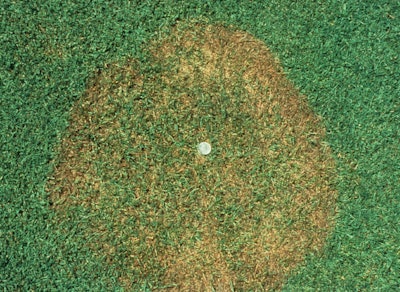
Brown Patch is a type of Rhizoctonia disease that affects turfgrass in hot, humid climates. Brown Patch initially starts out with a slight purple or green appearance and “smoke ring” edges, and the turf then turns to a dull tan or brown as the disease progresses. The fungus causes dull tan lesions on blades of grass, which may develop a reddish brown margin. Plants killed by the fungus will often have a light brown color, or straw color, and turn brittle.
Summer is the optimal time for Brown Patch in northern states and the fall in southern states. It thrives when temperatures are in the range of 75° to 95° F, with the optimal conditions for leaf colonization being temperatures of 85° to 90° F with high humidity or extended leaf wetness periods. Bentgrasses, fescues, ryegrasses and bluegrasses are all susceptible types of species.
Prevention and Treatment
A key factor in treatment is early identification. Brown Patch thrives when lawns have excess moisture (overwatering, high rain or humidity), and will continue to spread during the growing season if conditions aren’t changed. While most homeowners reach for the fertilizer to treat the brown patches, doing so can actually fuel the progression of the fungus. If fertilizers are applied, it’s important to use low to moderate levels of nitrogen-based fertilizers. Avoiding high rates of nitrogen fertilizer in the late spring and summer prevents the growth of lush grass that nitrogen promotes—and Brown Patch thrives on.
Controlling the level of moisture in the grass is important. Irrigation should only be done on grass when it’s needed, and only to a depth of 4 to 6 inches. It is also best to water early in the morning, because the disease spreads quickly when free moisture is present for more than 10 hours. Core aeration can also limit excess moisture and prevent excessive thatch buildup.
Prevent the disease from spreading by removing clippings when mowing. When mowing, keep the lawn at the height recommended for that species of grass. Keeping lawns at lower height has the potential to increase the disease severity. Soil pH also affects the severity of the disease; if the pH is less than 6.0, the lawn needs an application of lime.
Fungicide applications can be necessary if the moisture level cannot be controlled. Fungicides should only be applied when the nighttime low does not drop beneath 60°. Better control can be achieved by using liquid fungicides, rather than applying a granular product. Recommended fungicides:
- Azoxystrobin, which is applied every 14 to 28 days and offers the best control. Brand names include Heritage.
- Myclobutinil, which is applied every 14 to 28 days and offers good control. Brand names include Eagle and Immunox.
- Triadimefon, which is applied every 30 days and offers fair to good control. Brand names include Bayleton.
- Mancozeb, which is applied every 7 days and offers fair to good control. Brand names include Fore, Protect and Penncozeb.
Check out the lawn care tips on our website for more on Brown Patch and some of the products available to help treat it.
A larger list of recommended fungicides, that include granules, can be viewed at the Texas A&M Extension and Education website.



















